
Introduction to Siddhartha Gautama Buddha and Buddhism.
- Subject:
- Arts and Humanities
- Religious Studies
- Material Type:
- Lesson
- Provider:
- Khan Academy
- Date Added:
- 03/12/2021

Introduction to Siddhartha Gautama Buddha and Buddhism.
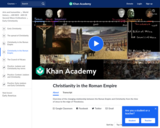
These videos address the topics of Early Christianity, The spread of Christianity, Christianity in the Roman Empire, and the Council of Nicaea.
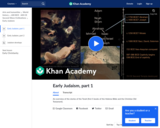
An overview of the stories of the Torah (first 5 books of the Hebrew Bible and the Christian Old Testament).
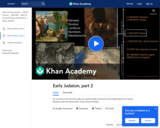
An overview from the first kings of a unified Judah and Israel to the beginning of the Jewish Diaspora with the destruction of the Second Temple.
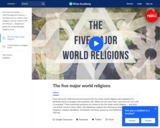
It's perfectly human to grapple with questions, like 'Where do we come from?' and 'How do I live a life of meaning?' These existential questions are central to the five major world religions -- and that's not all that connects these faiths. John Bellaimey explains the intertwined histories and cultures of Hinduism, Judaism, Buddhism, Christianity and Islam. Lesson by John Bellaimey, animation by TED-Ed.
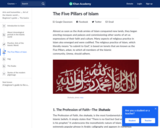
Almost as soon as the Arab armies of Islam conquered new lands, they began erecting mosques and palaces and commissioning other works of art as expressions of their faith and culture. Many aspects of religious practice in Islam also emerged and were codified. The religious practice of Islam, which literally means "to submit to God", is based on tenets that are known as the Five Pillars, arkan, to which all members of the Islamic community, Umma, should adhere.
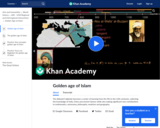
The Abbasid Caliphate becomes a center of learning from the 9th to the 13th centuries, collecting the knowledge of India, China and ancient Greece while also making significant new contributions to mathematics, astronomy, philosophy, medicine and geography.

One of the five pillars of Islam central to Muslim belief, Hajj is the pilgrimage to Mecca that every Muslim must make at least once in their lifetime if they are able; it is the most spiritual event that a Muslim experiences, observing rituals in the most sacred places in the Islamic world. Mecca is the birthplace of the Prophet Muhammad. The sanctuary there with the Ka‘ba is the holiest site in Islam. As such, it is a deeply spiritual destination for Muslims all over the world; it is the heart of Islam.
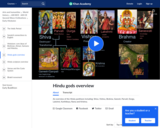
An overview of the Hindu pantheon including: Shiva, Vishnu, Brahma, Ganesh, Parvati, Durga, Lakshmi, Karthikeya, Rama and Krishna.

Hinduism is one of the oldest and largest religions in the world. It is also one of the most diverse in terms of practice. This video gives an overview of the central spiritual ideas of Brahman, Atman, Samsara and Moksha.
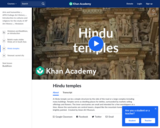
A Hindu temple can be a simple structure by the side of the road or a large complex including many buildings. Temples serve as dwelling places for deities, surrounded by markets selling offerings and flowers. The inner sanctuaries are small and intended for a few worshippers at a time. Above the sanctuaries are central towers, shaped like the mountain home of the gods and brightly painted.

After completing basic biblical Greek, students are often eager to continue to learn and strengthen their skills of translation and interpretation. This intermediate graded reader is designed to meet those needs. The reader is “intermediate” in the sense that it presumes the user will have already learned the basics of Greek grammar and syntax and has memorized Greek vocabulary words that appear frequently in the New Testament. The reader is “graded” in the sense that it moves from simpler translation work (Galatians) towards more advanced readings from the book of James, the Septuagint, and from one of the Church Fathers. In each reading lesson, the Greek text is given, followed by supplemental notes that offer help with vocabulary, challenging word forms, and syntax. Discussion questions are also included to foster group conversation and engagement. There are many good Greek readers in existence, but this reader differs from most others in a few important ways. Most readers offer text selections from different parts of the Bible, but in this reader the user works through one entire book (Galatians). All subsequent lessons, then, build off of this interaction with Galatians through short readings that are in some way related to Galatians. The Septuagint passages in the reader offer some broader context for texts that Paul quotes explicitly from the Septuagint. The Patristic reading from John Chrysystom comes from one of his homilies on Galatians. This approach to a Greek reader allows for both variety and coherence in the learning process.
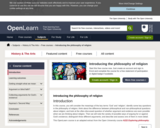
In this course, you will consider the meanings of the key terms ‘God’ and ‘religion’; identify some key questions in the philosophy of religion; think about the difference between philosophical and non-philosophical questions about religion, and look at the often-discussed question of whether argument and evidence are even possible when we are thinking about religion. Then we will note the variety of possible ways of arguing for or against God’s existence; distinguish three different arguments, and describe and assess one of them in more detail.
Note: the copyright holder must be contacted for permissions if a user wants to alter or transform the materials in any way. Please review the materials for more information.
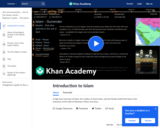
A high level overview of Islam, the 5 pillars of Sunni Islam, and the Muslim belief that Islam is the extension of the faith of Abraham, Moses and Jesus.
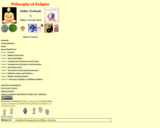
Here is a simple listing of what is to be considered in this text and course:
1. What is Philosophy of Religion?
2. What is Religion? What are the characteristics of Religion ?
3. What are the religions of the world?
4. What is God? What are the Attributes of deity (god) ?
5. Arguments for God's Existence: Are there any rational reasons to believe?
6. The Problem of Evil - Rational arguments for disbelief: how can God exist and ther be evil in the world?
7. Souls and the afterlife: What proof is there that souls survive death?
8. Faith vs. Reason - Are there other ways to find a basis for belief?
9. Religious Language: Do religious beliefs need to be based on truth? Should religious claims be subjected to scientific verification?
10. Morality and Religion: Is there any other basis possible for a moral foundation to support a social order?
11. What is the essence of Religion?
The objective of this work is to arrive at a critical, informed and accurate understanding of what religion is, what it is about and what value it may have in the contemporary world. It is designed to foster critical thinking concerning topics related to religion. It is designed to be challenging and hopefully of those who respond to the challenge it will prove to be rewarding of the effort.
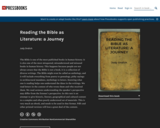
Short Description:
The Bible is one of the most published books in human history. It is also one of the most misquoted, misunderstood and misused books in human history. This happens because people are not always aware that the Bible is not a book, it is a collection of diverse writings. The Bible might even be called an anthology, and it will include everything from poetry to genealogy, pithy sayings to architectural mandates, mythology to letters. Knowing what one is reading helps one understand the ideas in the writings. We read letters in the context of who wrote them and who received them. We read sermons understanding the speaker's perspective may differ from the listener's perspective. So this text is an attempt to give historic, literary, geographical and cultural context to a complex and often poorly understood set of materials. This is very much an ebook, and needs to be used in that format. Pdfs and other printed versions will lose a great deal of the content.
Word Count: 138043
Included H5P activities: 8
(Note: This resource's metadata has been created automatically as part of a bulk import process by reformatting and/or combining the information that the author initially provided. As a result, there may be errors in formatting.)
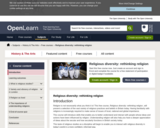
Religion is not necessarily what you think it is! This free course, Religious diversity: rethinking religion, will present a selection of the vast variety of religious practices and beliefs in Britain today. Having familiarity with religions is increasingly required to make sense of issues of local, national and global importance.
This course will introduce skills that enable you to better understand and interact with people whose ideas and actions have been influenced by religion. Understanding religion will also help you have a deeper appreciation of ideas about the secular and how secularity functions in British society today.
This taste of religious studies as a discipline will begin to enable you to interact with religious diversity in today’s world in a more confident, informed way.
This course will also give you a taste of the Open University course A227 Exploring religion: places, practices, texts and experiences. This short free course focuses on a selection of religious places and practices in London. However, the full course explores religion in a more global context, with a focus on how religion is actually lived and practiced.
Note: the copyright holder must be contacted for permissions if a user wants to alter or transform the materials in any way. Please review the materials for more information.

1: Zoroastrian Scriptures
1.1: Ahura Mazda and Angra Mainyu
1.2: The Coming of Saoshyant
2: Hindu Scriptures
2.1: Vedic Creation Hymn
2.2: The Isha Upanishad
2.3: Chandogya Upanishad
2.4: Bhagavad Gita
3: Buddhist Scriptures
3.1: The Life of the Buddha - Buddha’s Escape from his life of Luxury
3.2: The Dhammapada Lecture One
3.3: The Heart Sutra
4: Jewish Scriptures
4.1: Bereshit – The Opening of the Torah
4.2: Moshe is Called by God
4.3: Talmud
4.4: Kabbalah
5: Christian Scriptures
5.1: The Beatitudes
5.2: Resurrection of Jesus
5.3: Paul’s Discourse on Love
5.4: Book of Revelations
6: Muslim Scriptures
6.1: The Fatihah
6.2: The Quran
6.3: Surah 96
6.4: Hadith Abu-Dawud

An introduction to Shinto, one of Japan's earliest belief systems. Created by Asian Art Museum.

An overview of the founding of the Sikh religion started by Guru Nanak. Discussion of persecution by the Mughals and militarization by Gurus Har Gobind, Teg Bahadur and Gobind Singh. Overview of Khalsa.